Pakistani Club Sandwiches
Back in 2015, before we’d even been at this a full year, I wrote a piece that I humbly submit may be the internet’s definitive writeup on the history of the club sandwich. Certainly a more delicious history of the club sandwich than anything else I’ve read1, as I recreated the sandwich throughout various incarnations it’s had since its inception in the late 1880s, from the simple warm sandwich of turkey and broiled bacon on toasted Graham bread to the intricate stack of bread, meats, and vegetables it eventually became. I concluded at that time that the defining feature of the club sandwich was not its multiple layers but rather the combination of fowl–chicken or turkey, usually–with cured pork–preferably bacon but sometimes ham. (See for example any fast food “chicken club” sandwich.)
Were there things about my “Edible History of the Club Sandwich” that I had rethought in the interim, like my insistence on using “triple-decker” when clearly “double-decker” was more appropriate? Sure. But it was still a great piece. I had written, I thought, all I needed to write about club sandwiches, and left them behind me.
Then in June of 2019, Thrillist published their piece “Around the World in 80 Sandwiches” wherein they mention the Pakistani-style club sandwich. Suddenly there was more to write about the club sandwich.
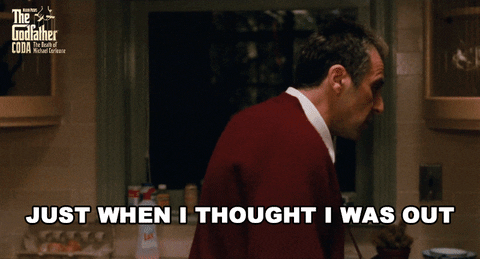
At its core, the Pakistani club sandwich is a refutation of my earlier research and conclusions about club sandwiches–that is, the Pakistani club sandwich is not a combination of fowl and cured pork, as the latter is haram in Islamic beliefs.
Anecdotally, even the mainly secular people I’ve met with a muslim background continue to avoid pork when not actively practicing Islam, whereas many non-religious jews I know have grown to embrace the magic qualities of pork, in barbecue, in charcuterie, in sausage-making, and simply in general culinary use. Both religions have similar dietary requirements (kosher vs halal) and prohibitions (treif vs haram), but the social taboo against pork seems stronger for muslims. Those secular muslims I’ve discussed it with tell me the very idea of eating pork is disgusting to them. Again, this observation is entirely my own.
Clearly a club sandwich originating in a highly Islamic culture like that of Pakistan would not pattern itself after the turkey/bacon/tomato connection posited in my previous piece. While it’s true that this was historically the idea behind a club sandwich, that combination of sliced roasted white meat with pink and salty pork in warm, toasted bread, the double-decker construction is by far the more common referent today. See for example the “California Club” sandwich, not codified by any means but likely to contain some combination of sprouts and/or avocado in addition to standard club sandwich ingredients and the requisite 3 slices of bread. Similarly the salmon club sandwich, the tuna club sandwich. Many shops across the US offer Vegetarian club sandwiches, which may feature any number of ingredients including a plethora of vegetables and meat substitutes but will invariably be served as double-deckers.
Ultimately, I had made the classic blunder of choosing the prescriptivist approach over the descriptivist. Who am I to tell the world it is wrong about club sandwiches? I am certainly no James Beard, despite being named James and sporting a rather spectacular beard, if I say so myself.
Back in 2019 when I first read about the sandwich, I asked my Pakistani-American friend Syed about this Pakistani club sandwich. To my surprise2, he was quite aware of it and had a ready recommendation for the best place to get one. Syed had tried a few in his time and recommended the club sandwich at Shahi Nihari & Chopsticks in west suburban Villa Park.

Shortly thereafter, Mindy and I had a rare free afternoon together and drove out to Villa Park to try Shahi Nihari. Mindy wisely chose to order the dish they’d named the restaurant after, Beef Nihari, a rich and deeply-flavored stew of slow-cooked beef, slick with rendered fat, gelatin, and marrow. The proprietor hovered nearby, instructing us how to scoop the beef from the gravy and dress it in some of the provided accompaniments–slivers of ginger, thin slices of onion and jalapeno, cucumber, some lime wedges. It is exactly the kind of Pakistani dish I like, rich, spicy, and fatty, served with good naan.




Mindy got the better end of this deal, but the club sandwich was also a solid recommendation from Syed. Served on thick soft slices of bread, warm but only very lightly toasted if at all, it consisted of masala-coated tandoori-roasted chicken, quite spicy, with a chili mayonnaise sauce, thick slices of tomato, lettuce, and American cheese. I was impressed enough with it that over the course of the past couple years, I’ve returned to Shahi Nihari a few more times for that sandwich, whenever I’ve been in the area.
This month though I decided to try a few different versions of the sandwich if I could. I searched menus in the Naperville area, generally a good source of South Asian fare, but I did not identify any restaurants serving the Pakistani-style club sandwich. I did find a small cluster on Devon Avenue in Chicago though.

“Usmania Fine Dining Restaurant”–directly across the street from “Usmania Zabiha Chinese Restaurant”–presents a puzzling facade. There’s an enclosed patio behind that glass, with a host greeting guests and ushering them into a dim interior. We didn’t make it all the way in, ordering a club sandwich to go. The sandwich was made to order, involving a 20 minute wait, and when it was done we took it to a nearby bench along Devon.
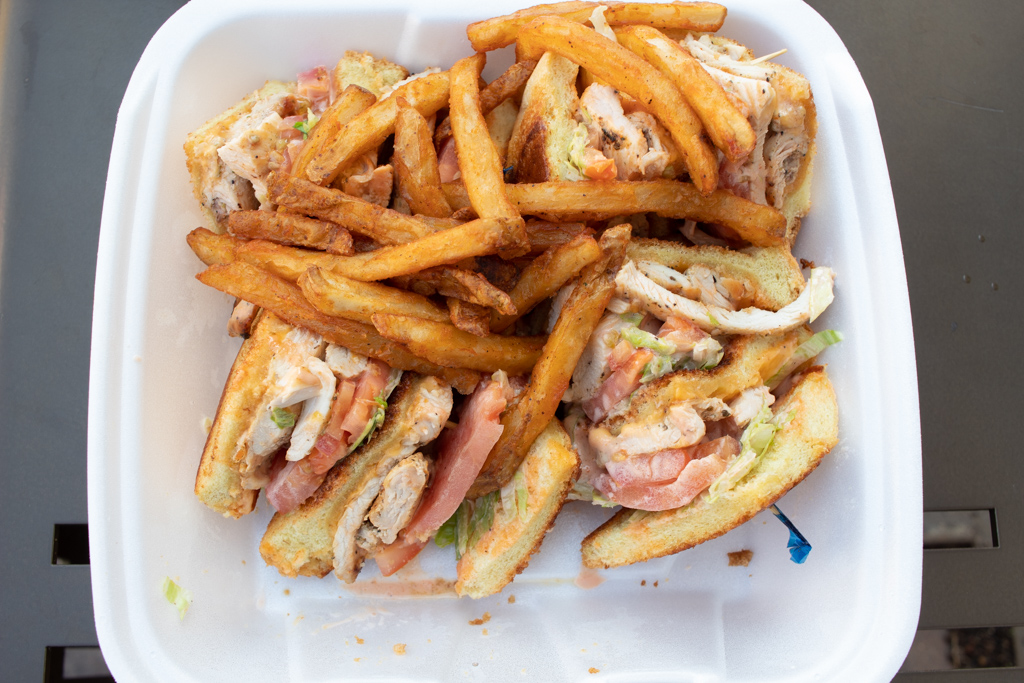
The club sandwich from Usmania was almost identical to what I’d had previously at Shahi Nihari, with the exception that the bread was more thoroughly toasted. Thick pieces of masala-coated roasted chicken? Check. Spicy mayonnaise? Check. Waxy yellow American cheese gluing the chicken to one slice of bread? Check. Cut into 4 triangles with fries in the middle, in the classic American club sandwich presentation? Check and check.
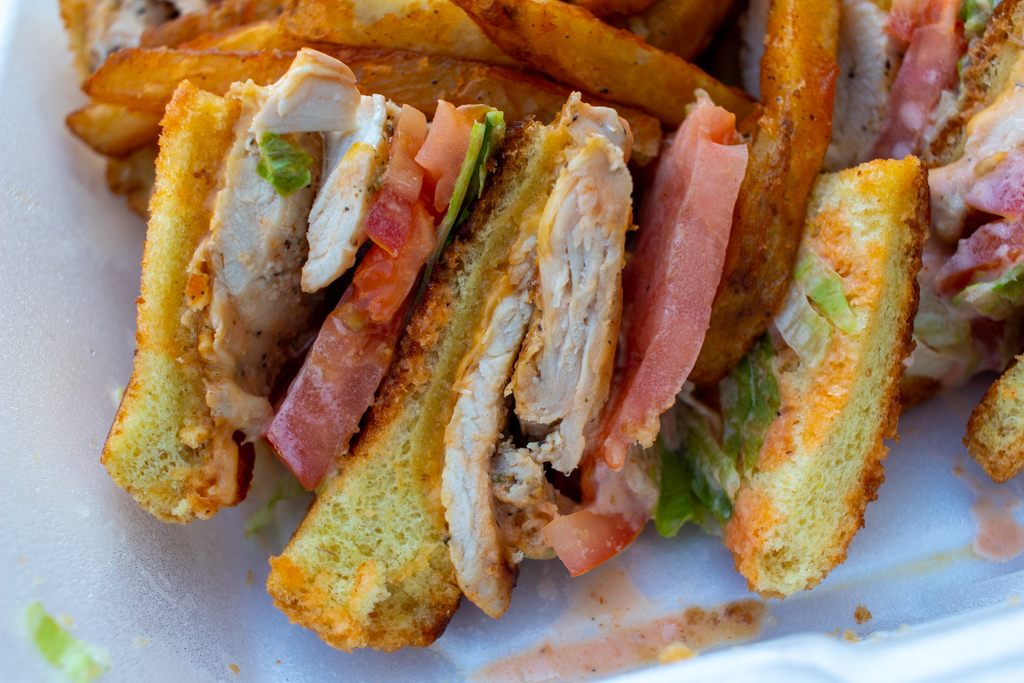
Well maybe there wasn’t any American cheese, though I certainly thought I tasted it. And maybe instead of, or in addition to a spicy mayonnaise, there is an orangish chutney providing some heat and additional flavor. Regardless, it’s an enjoyable sandwich, and I can certainly see myself ordering more of them when the mood strikes. But if this was all there was to the Pakistani club sandwich, I wouldn’t find much to write about them.

Thankfully, that turned out not to be the case. A few doors west of Usmania lies King Sweets, home to what ended up being my favorite Bun Kebab on Devon when I explored that Pakistani sandwich six, nearly seven years ago. King Sweets was doing brisk business on a Saturday afternoon between those coming in for a package of barfi to go and those taking a table and waiting on freshly made chaat. Again, we ordered a club sandwich and took it to the same bench.
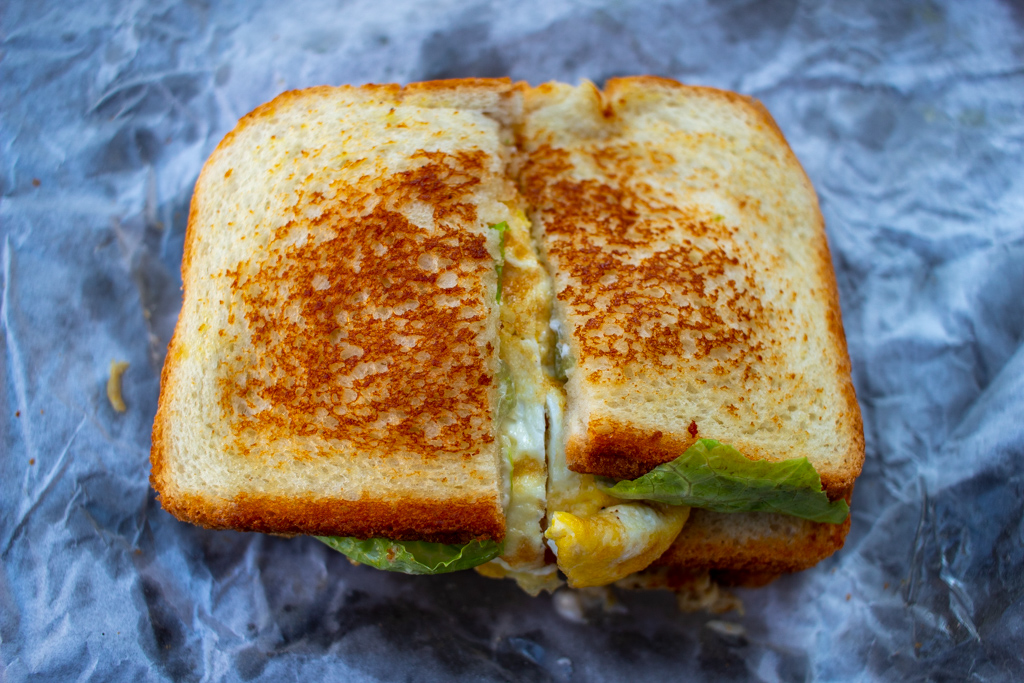
First off, yes, this sandwich was cut in two rectangles instead of the usual four triangles. And yes, the trained eye will spot what appears to be a fried egg under that top layer of lettuce. Let’s take a closer look inside though.
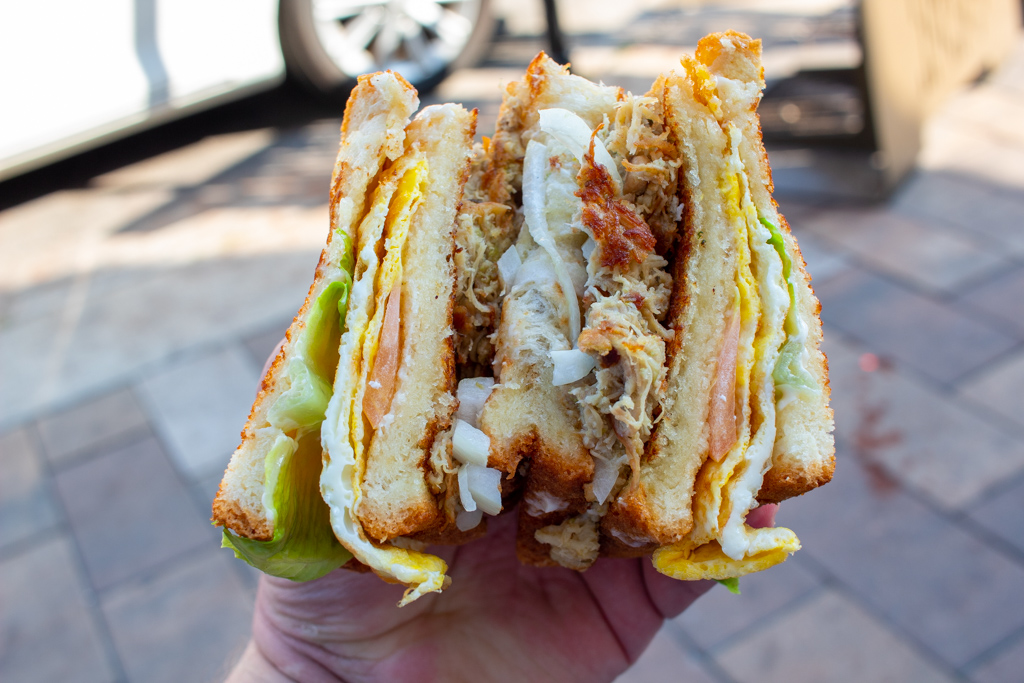
This sandwich was so little like what I’d come to expect from a Pakistani club sandwich that my mind had a hard time processing it at first. The main protein is a shredded chicken rather than solid pieces of tandoori roasted chicken, and that shredded chicken appears to have browned bits, as if it was formed into a patty of some kind and reheated on a griddle. It is served in the bottom “deck” of the sandwich along with thick slices of raw onion. The other half of the double-decker consists of a fried egg, mayonnaise, tomato, and lettuce.
The bread is well-toasted, and apart from the unorthodox rectangular cut, the sandwich is constructed and presented something like a classic club. The combination, though, tastes nothing like a club sandwich. Whereas the versions from Shahi Nihari and Usmania seemed familiar, with the heat of the spicy masalas taking the place of the salt and smoke of the bacon, the onion, egg, and shredded chicken here does not register as a club sandwich, or at least not to me. It wasn’t a bad sandwich–a surprising one, sure, but well-made and interesting.

The surprises didn’t end there. Karachi Chat House, within a stone’s throw of both Usmania and King Sweets, also offered a club sandwich, so we stopped in to try theirs. Since there would be another 20 minute wait, and since the restaurant was completely empty, this time we opted to sit inside.
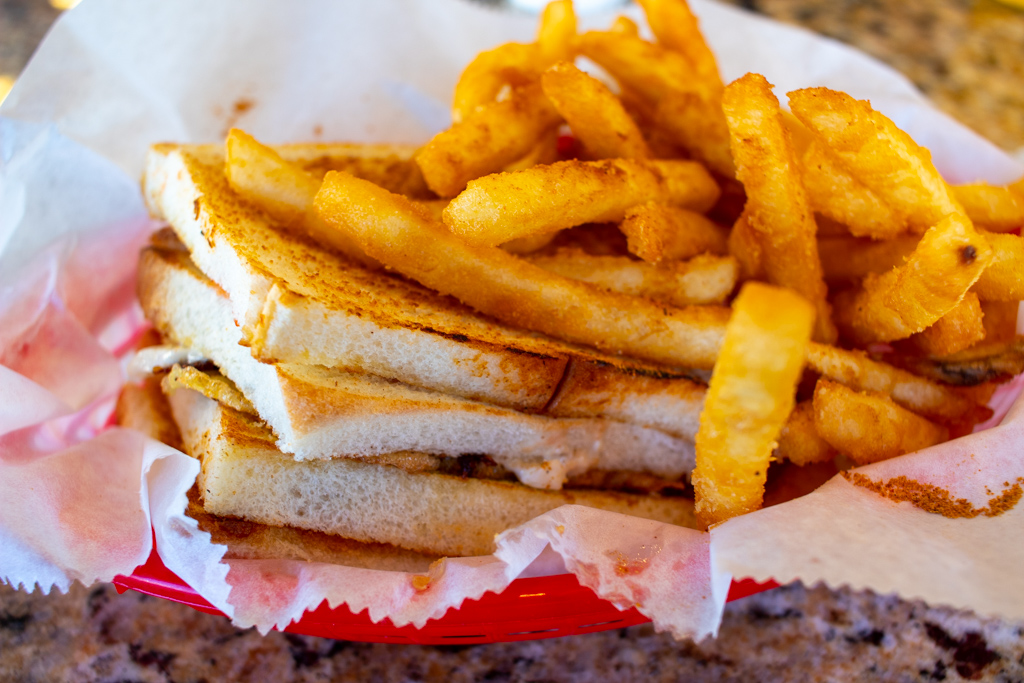
Karachi’s club sandwich was served with the crusts removed, an order of decent masala fries sharing a boat with the sandwich. There was something else unusual about the sandwich, somewhat obscured as it was by the pile of fries. Here is a closer look.

First off, this appears to be a legitimate triple-decker–the sandwich encompasses four entire slices of toasted bread. This as much as anything else has led me to adopt the “double-decker” terminology for the standard 3-slice club sandwich. On the other hand, two of those slices of bread appear to be entirely unnecessary. Between the central two slices we have shredded chicken, a fried egg, and a mixture of raw onion, mayonnaise, herbs and possibly additional vegetables that is very much like a coleslaw. However, the bottom two slices are separated only by a slice of American cheese, and the top two by even less, a simple swipe of ketchup.
For all that, I liked this sandwich better than the version from King Sweets. The slaw-or-whatever-it-was made a more fitting accompaniment for the shredded chicken than the thick slices of raw onion had. The chicken itself, also seemingly formed into a kebab and griddled like King Sweets’ had been, was more convincingly kebab-like, moister and better-seasoned. There was a more proportionate amount of egg, though I wouldn’t have complained if there’d been more. Even those seemingly useless ketchup and cheese layers added some needed umami, though they could have done so without being separated from the other ingredients by a layer of toast, I think.
I reached out to my friend Syed again and told him about these different types of Pakistani club sandwiches I’d found at King Sweets and Karachi Chat House. He was as surprised as I had been. “I have never seen shredded chicken club sandwiches,” he said. “This must be a new style, which I would love to try.”
Syed defended King Sweets as well, though he needn’t have: I like a great many things about that shop, though I was not a fan of its version of the club sandwich. “The nice thing about King Sweets is that they have (or at least used to) real Kashmiri Chai rather than regular Indian chai with pink food coloring in it. The real stuff is well worth the 1-hour long cooking process.” And so now I must return to King Sweets and try that, likely with some of my tea-loving children accompanying me.
Finally I asked Syed if there were any other Pakistani-style club sandwiches that he would recommend I try, since that initial recommendation of Shahi Nihari two and a half years ago. He polled his friends and they steered me toward a small local chain of Pakistani fast-food restaurants called Mr. Broast.

As the name indicates, Mr. Broast offers chicken that is broasted; that is, it is cooked in a type of branded pressure fryer known as a broaster. The halal chicken used by Mr. Broast turns out exceptionally well when broasted–very lightly coated in flour and simply seasoned, the finished version is crisp-skinned and bursting with juices.
However, I come not to praise their chicken–though I’ll be back to eat it again, and soon. I come to bury my face in one of these gigantic club sandwiches.
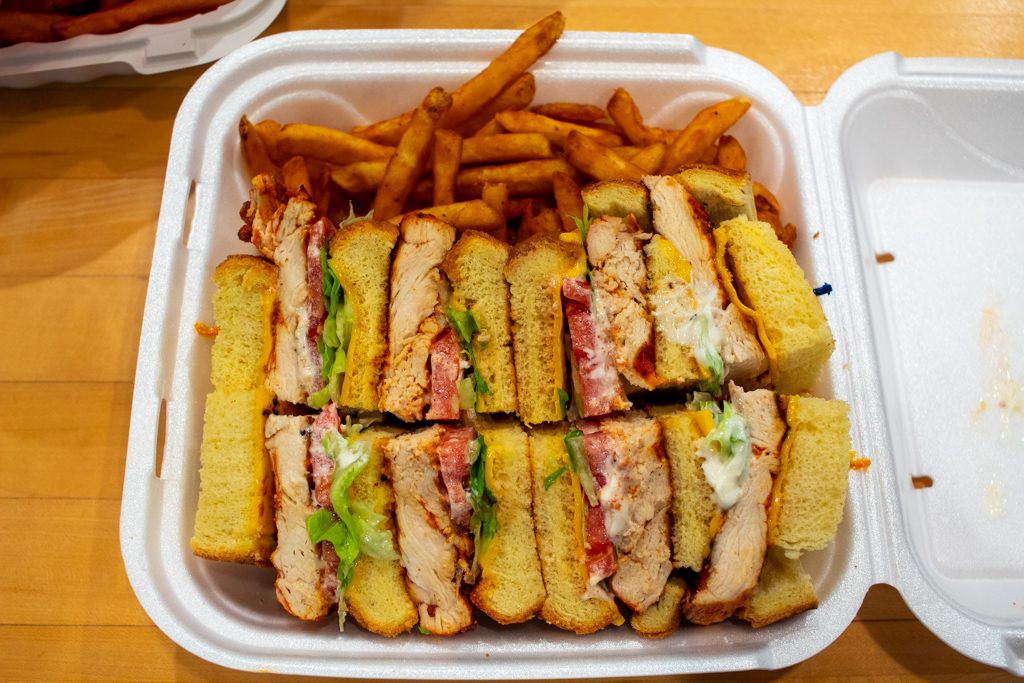
Once again, in almost every respect, this sandwich is a clone of that first Pakistani club sandwich I had from Shahi Nihari back in June of 2019. The same thick-sliced bread, the same not-quite-melted American cheese. Slightly spicier masala coating the chicken, and considerably better tomatoes. Still, very much the same sandwich.
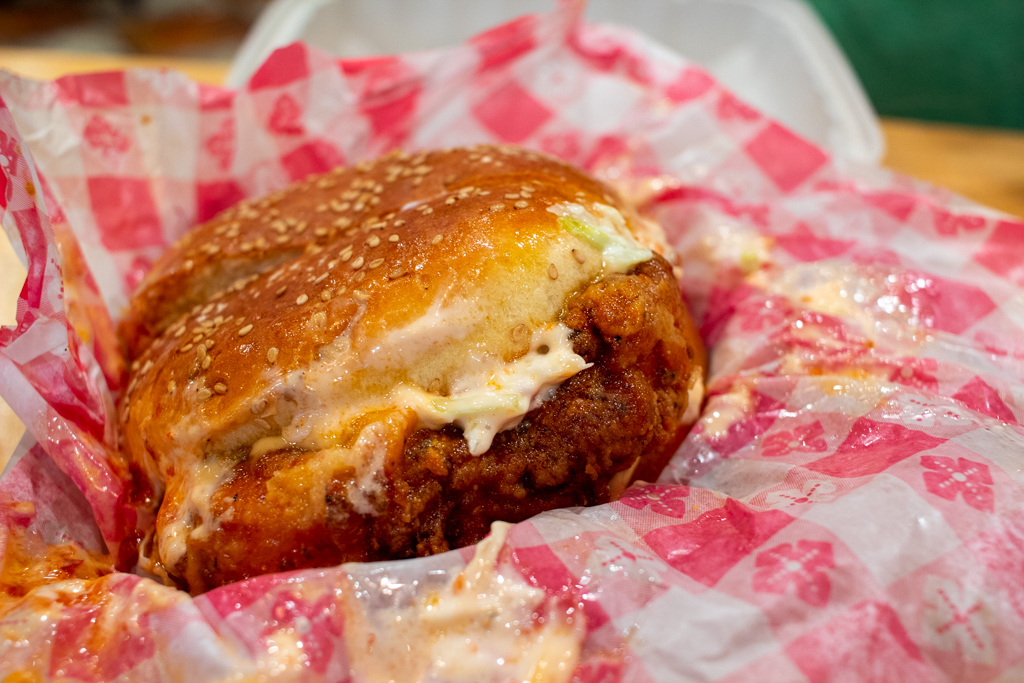
Ian’s chicken zinger was a delight though, a thick, crisply-breaded piece of chicken in a sesame seed bun, served with cole slaw and a spicy “zinger sauce.” Ian ordered the mild version of the sandwich and I found the bite I had to be surprisingly spicy. Unless they made his sandwich wrong, I’d guess that the hot version sports some legitimate heat.
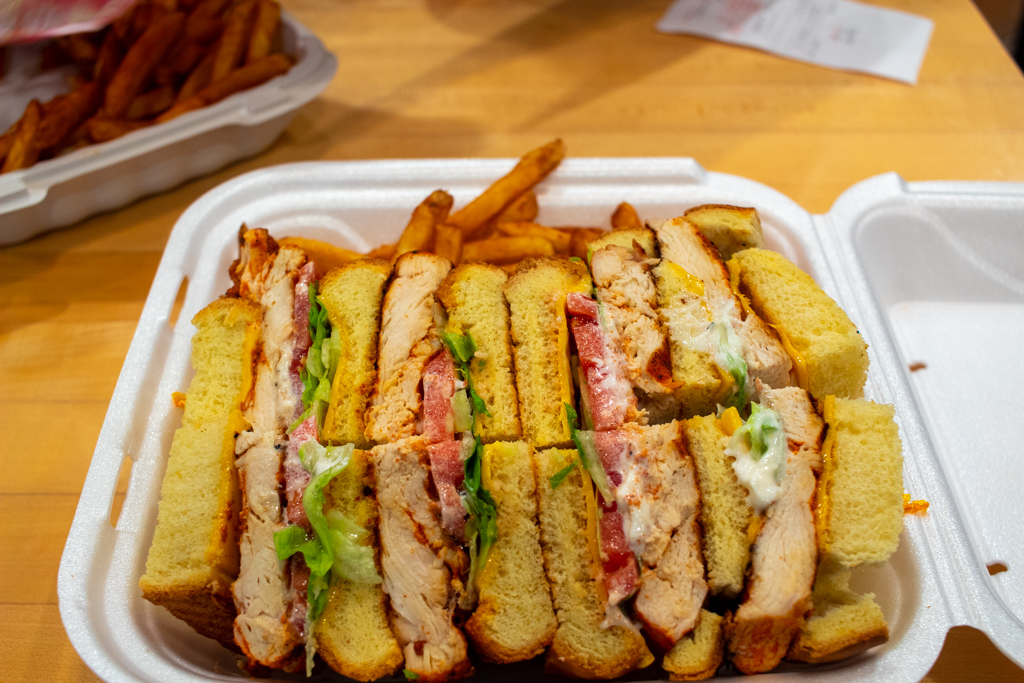
When we return though, I don’t think we’ll be trying either the chicken zinger burger or the club sandwich. That broasted chicken is calling my name.
1 Remember kids, if you are reading a writeup of club sandwiches and they seriously suggest that the name is an acronym for Chicken Lettuce Under Bacon you should never take anything that writer or website publishes seriously ever again. I try to be understanding but this idiot backronym has plagued me for years and I will not rest until I see it scoured from the internet, its proponents shamed into hiding.
2 As an aside: Guys, if we’re friends and you know about a sandwich that I haven’t heard of you are legally required to tell me about it rather than let me read about it in some Thrillist article, no matter how great and well-researched that article is! I’m pretty sure this legal requirement is 100% factual so please don’t bother looking it up, just take my word for it and send me all your secret sandwich details please.

I like sandwiches.
I like a lot of other things too but sandwiches are pretty great





Recent Comments